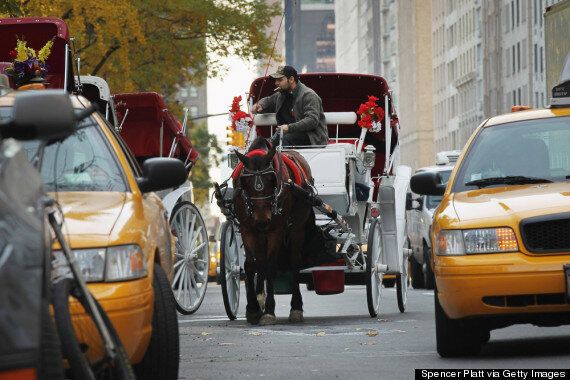NEW YORK -- Liam Neeson, the actor best know for threatening to "find" and "kill" a gang of Albanian human traffickers in the film Taken, stepped into the middle of a row over animal welfare on Sunday, hosting several members of the City Council at Clinton Park Stables, which houses around 80 of the horses that pull carriages around New York’s iconic Central Park.
In recent months, animal-rights activists have made progress in moving the city towards a ban on horse drawn carriages, with electric cars one alternative proposed for moving tourists around the 840-acre landmark in Upper Manhattan.

Neeson said the mayor should have 'manned up and come'
Newly-elected Mayor Bill de Blasio made a campaign promise to ban the industry, while a raft of celebrities have backed the proposed prohibition, including Alec Baldwin and Miley Cyrus. However, Neeson, a long-time resident of the city, has gone the other way, highlighting the plight of the carriage operators who stand to go out of business should their industry be outlawed.
"This is an industry that’s been here since before Abraham Lincoln’s first inauguration," said the actor during a visit to the stables on Sunday. "A beautiful industry it is," he added. "It’s a connection with our past."
The Irish-born actor, who shot to global fame portraying Oscar Schindler in Stephen Spielberg’s 1993 film Schindler’s List, gave a tour of the straw-strewn stables to a dozen members of the City Council in an effort to emphasise that the carriage horses were properly cared for. He also introduced the press to some of the carriage drivers who stand to lose their jobs should the ban become law.

New York's famous horse draw carriages have been operating for centuries
Neeson’s desire to keep the horse-drawn carriages, many of which have Irish drivers, has some support with the residents of the city, with a January 2014 poll finding that 61 per cent of voters think the mayor should leave the industry as it is.
However, the actor's plea is unlikely to dissuade either the Mayor or the activists who have campaigned on behalf of the animals. When asked about de Blasio’s absence from the tour, Nesson quipped: "He should have manned up and come."
At a press conference a few hours later, the mayor reiterated that he would not change his mind. "I am someone who thought the carriages were sort of part of life in New York City, and I’ve traveled my own journey coming to the view that it really didn’t make sense anymore."
According to the New York Times, the "journey" for the mayor included a $1.3 million contribution to his election fund by the activists seeking to ban carriage horse from New York’s streets.
Politics aside, campaigners remain adamant that the horses endure a life of suffering, despite legislation introduced in 2010 to ensure better living conditions for the animals.

The horses work in traffic beside Central Park, which has led to several serious incidents
The American Society for the Prevention of Cruelty to Animals (ASPCA) recently said that they do not oppose horse work, but "horses pulling carriages in New York City" where they are surrounded by "buses, cabs and traffic". The ASPCA added: "We believe that it no longer is, nor ever was, quaint or romantic."
Others have gone further comparing the life of the carriage horses to that of a prison, with nasty several incidents in recent years involving cars and taxis around the park only strengthening the case against the carriages.
Should the ban come into effect, the horses would be forced to go into retirement at horse sanctuaries, while the drivers would be forced to look for other jobs. However, as opponents of the ban point out, the high costs of keeping horses could mean that many of New York’s carriage horses could end up being sold for slaughter.